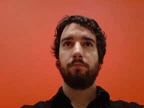
With images ranging from banana trees, a football, a bag of rice and a village path, residents of the eight villages surrounding the Tiwai Island Wildlife Sanctuary are sharing the things they want to protect for future generations.
The project is meant to build stronger connections to the reserve and to help protect their culture from increased tourism.
Thirty-two people participated in the photo-voice project, organized by Canadian researcher Jennifer Thompson of McGill University and the Environmental Foundation for Africa, the organization that operates the sanctuary.
Thompson had people take photos of the things in their community that the wanted to preserve for future generations.
"It's cultural conservation," she said, explaining that the project gives communities an chance to voice their concerns about the Tiwai Island project and decide what they want to keep and build on for the future.
"It's a dialog that will continue using a tool that local people don't normally have access to," Thompson said. "Using visuals to explore how people feel about a place is kind of new."
Tensions
The Tiwai Island Wildlife Sanctuary has one of the highest concentrations of primates in the world. Eleven species, including the endangered colobus and Diana monkeys and wild chimpanzees, live alongside pygmy hippopotamus and 135 different bird species.
Originally a research station, the reserve was created in 1987 as a way to provide for the communities while protecting wildlife. It was destroyed during the war, and rebuilt starting in 2001. The sanctuary received its first visitors in 2004.
Even though the creation of the wildlife sanctuary was a community-driven project, the relationship between the wildlife sanctuary and the nearby villages has been strained.
The island is known to have mineral deposits, including diamonds. But farming, mining and hunting are not allowed in the reserve, so villagers have given up potential income from these activities.
The communities do get some money from the sanctuary. Forty per cent of the visitor's fees go to fund community projects, including the ongoing construction of a mosque and a school. Tiwai also employs eight permanent workers and four night staff.
But some villagers expected to earn more money from the researchers and tourists coming to the reserve. It is hoped that Tiwai will eventually become an economic engine for the area, but this will take time.
Community Impact
Thompson hopes that the photo-voice project can help address some of the concerns and create a sustained dialog and bring Tiwai and the surrounding communities together.
Momoh Magona, the project officer with the Tiwai Island Wildlife Sanctuary, thinks the project has already been successful.
"The project is a good one," he said. "They [local villagers] like that their voices are being heard and they now feel that they are part of us."
James Gbomgbotoh, 18, lives in Kambama village near Tiwai. He participated in the photo-voice project in order to share what he had learned after moving from Bo Town.
"I'm from far away [Bo] and I heard about Tiwai and I heard it was popular. When I got to Kambama I didn't respect it," he said. "There were no zinc houses, there was bush inside the town."
Taking part in the photo voice project allowed Gbomgbotoh to identify the areas of his village that needed to be improved as well as the things that needed to be protected.
"The way I see it, whatever your eyes see, that's what you should talk about. Like the mosque, it's broken. I took pictures of the mosque. It was not built fine. If it is a place where you worship God, it should be fine," he said.
"I took a picture of the water pump because it is not enough," he continued. "When women come in the evening to take water it is dirty. If there were two or three [pumps in the community] it would be fine."
He also took a picture of the school. "My brother and sister have to walk to Vaama everyday. They've started to build a school in Kambama, but it is not done."
Ownership
Catherine Kerr, an ecotourism advisor working with the Environmental Foundation for Africa, said each village is involved with decision-making for the reserve.
The Tiwai Island Administration Committee, which meets monthly, includes representatives from the communities. Government, universities, community members and other stakeholders meet to discuss the community development projects that Tiwai is able to fund.
The VSO Secure Livelihoods Programme, which placed Kerr with EFA, works to ensure that people have a reasonable standard of living, diversify livelihoods and build skills training.
For Tiwai this means making sure that the wildlife sanctuary operates in a sustainable way while involving local people in an economic and cultural partnership.
Additional funding is being sought for programmes that will directly benefit the community, including agriculture and arts and crafts training. Villagers will then be able to supply the sanctuary with the food and goods they make.
Gbomgbotoh believes that the eight villages surrounding Tiwai do benefit from the sanctuary, even if the impact is not felt immediately.
"The way I see it, Kambama has Tiwai totally," he said. "Tiwai makes Kambama improve. Visitors who come here leave money here. This money goes to help Kambama and the other communities. When there is money for development there should be decisions taken between Tiwai and the communities. The communities own Tiwai."

No comments:
Post a Comment